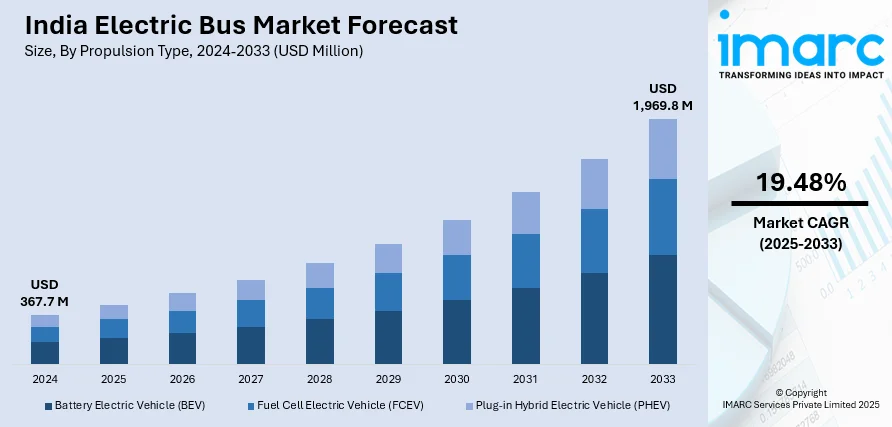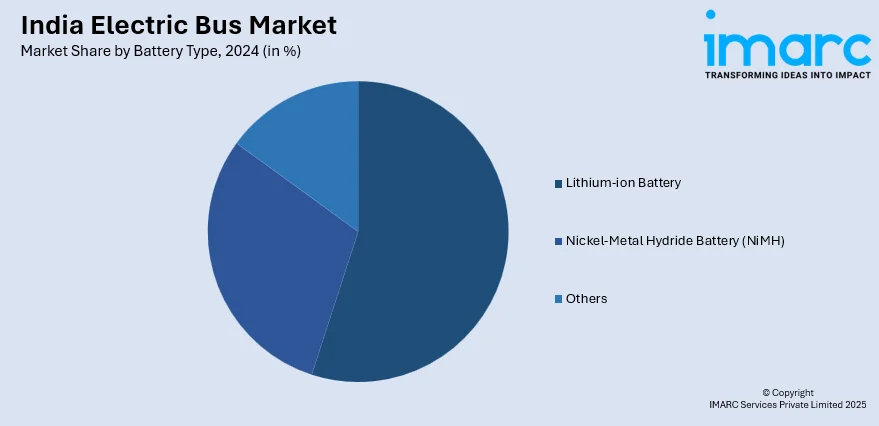
India Electric Bus Market Size, Share, Trends and Forecast by Propulsion Type, Battery Type, Length, Range, Battery Capacity, and Region, 2025-2033
Market Overview:
India electric bus market size reached USD 367.7 Million in 2024. Looking forward, IMARC Group expects the market to reach USD 1,969.8 Million by 2033, exhibiting a growth rate (CAGR) of 19.48% during 2025-2033. The widespread adoption of sustainable transportation solutions and the implementation of stringent regulations by government bodies aimed at curbing carbon dioxide emissions from conventional fuel vehicles are primarily driving the market growth.
|
Report Attribute
|
Key Statistics
|
|---|---|
|
Base Year
|
2024
|
|
Forecast Years
|
2025-2033
|
|
Historical Years
|
2019-2024
|
|
Market Size in 2024
|
USD 367.7 Million |
|
Market Forecast in 2033
|
USD 1,969.8 Million |
| Market Growth Rate 2025-2033 | 19.48% |
An electric bus, commonly referred to as an e-bus, is entirely powered by electricity, representing a sustainable and environmentally friendly form of public transportation. Instead of relying on fossil fuels, it utilizes electric motors and batteries for operation. Notably, electric buses generate zero tailpipe emissions, thereby contributing significantly to the improvement of air quality and the reduction of greenhouse gas (GHG) emissions. One noteworthy advantage of electric buses is the absence of noise and a smoother ride, ultimately enhancing the overall passenger experience. They reflect a commitment to eco-conscious practices and a progressive approach to addressing transportation challenges within public transit systems. The integration of electric buses into these systems signifies a dedication to environmentally sustainable modes of transportation and a forward-looking perspective on meeting the evolving needs of urban mobility while minimizing the ecological impact.

To get more information on this market, Request Sample
India Electric Bus Market Trends:
The electric bus market in India has witnessed a significant surge in recent years, marking a pivotal shift towards sustainable and eco-friendly public transportation. Fueled by the increasing awareness of environmental issues, government initiatives, and advancements in technology, the adoption of electric buses is transforming the landscape of urban mobility in the country. Additionally, India's electric bus market is driven by the imperative to address air pollution and reduce the carbon footprint associated with traditional fossil fuel-powered buses. Besides this, as major cities grapple with rising pollution levels and traffic congestion, electric buses have emerged as a viable solution to promote cleaner and more efficient public transportation systems. Moreover, government initiatives have played a crucial role in incentivizing the adoption of electric buses. Apart from this, the emphasis on smart city projects and sustainable urban development has propelled the demand for electric buses as an integral component of modern and environmentally conscious public transit systems. Additionally, the operational cost of electric buses is often lower over the long term, making them an economically viable choice for fleet operators. As the country continues to prioritize sustainable transportation solutions, the electric bus market is poised for sustained growth in the coming years.
India Electric Bus Market Segmentation:
IMARC Group provides an analysis of the key trends in each segment of the market, along with forecasts at the country level for 2025-2033. Our report has categorized the market based on propulsion type, battery type, length, range, and battery capacity.
Propulsion Type Insights:
- Battery Electric Vehicle (BEV)
- Fuel Cell Electric Vehicle (FCEV)
- Plug-in Hybrid Electric Vehicle (PHEV)
The report has provided a detailed breakup and analysis of the market based on the propulsion type. This includes battery electric vehicle (BEV), fuel cell electric vehicle (FCEV), and plug-in hybrid electric vehicle (PHEV).
Battery Type Insights:

- Lithium-ion Battery
- Nickel-Metal Hydride Battery (NiMH)
- Others
A detailed breakup and analysis of the market based on the battery type have also been provided in the report. This includes lithium-ion battery, nickel-metal hydride battery (NiMH), and others.
Length Insights:
- Less Than 9 Meters
- 9-14 Meters
- Above 14 Meters
The report has provided a detailed breakup and analysis of the market based on the length. This includes less than 9 meters, 9-14 meters, and above 14 meters.
Range Insights:
- Less Than 200 Miles
- More Than 200 Miles
A detailed breakup and analysis of the market based on the range have also been provided in the report. This includes less than 200 miles and more than 200 miles.
Battery Capacity Insights:
- Up To 400 kWh
- Above 400 kWh
The report has provided a detailed breakup and analysis of the market based on battery capacity. This includes up to 400 kWh and above 400 kWh.
Regional Insights:
- North India
- West and Central India
- South India
- East and Northeast India
The report has also provided a comprehensive analysis of all the major regional markets, which include North India, West and Central India, South India, and East and Northeast India.
Competitive Landscape:
The market research report has also provided a comprehensive analysis of the competitive landscape. Competitive analysis such as market structure, key player positioning, top winning strategies, competitive dashboard, and company evaluation quadrant has been covered in the report. Also, detailed profiles of all major companies have been provided.
India Electric Bus Market Report Coverage:
| Report Features | Details |
|---|---|
| Base Year of the Analysis | 2024 |
| Historical Period | 2019-2024 |
| Forecast Period | 2025-2033 |
| Units | Million USD |
| Scope of the Report | Exploration of Historical Trends and Market Outlook, Industry Catalysts and Challenges, Segment-Wise Historical and Future Market Assessment:
|
| Propulsion Types Covered | Battery Electric Vehicle (BEV), Fuel Cell Electric Vehicle (FCEV), Plug-in Hybrid Electric Vehicle (PHEV) |
| Battery Types Covered | Lithium-ion Battery, Nickel-Metal Hydride Battery (NiMH), Others |
| Lengths Covered | Less Than 9 Meters, 9-14 Meters, Above 14 Meters |
| Ranges Covered | Less Than 200 Miles, More Than 200 Miles |
| Battery Capacities Covered | Up To 400 kWh, Above 400 kWh |
| Regions Covered | North India, West and Central India, South India, East and Northeast India |
| Customization Scope | 10% Free Customization |
| Post-Sale Analyst Support | 10-12 Weeks |
| Delivery Format | PDF and Excel through Email (We can also provide the editable version of the report in PPT/Word format on special request) |
Key Benefits for Stakeholders:
- IMARC’s industry report offers a comprehensive quantitative analysis of various market segments, historical and current market trends, market forecasts, and dynamics of the India electric bus market from 2019-2033.
- The research report provides the latest information on the market drivers, challenges, and opportunities in the India electric bus market.
- Porter's five forces analysis assist stakeholders in assessing the impact of new entrants, competitive rivalry, supplier power, buyer power, and the threat of substitution. It helps stakeholders to analyze the level of competition within the India electric bus industry and its attractiveness.
- Competitive landscape allows stakeholders to understand their competitive environment and provides an insight into the current positions of key players in the market.
Key Questions Answered in This Report
The electric bus market in India was valued at USD 367.7 Million in 2024.
The electric bus market in India is projected to exhibit a CAGR of 19.48% during 2025-2033, reaching a value of USD 1,969.8 Million by 2033.
Stringent government regulations on vehicle emissions, increased focus on smart cities, and financial incentives are key growth drivers. Rising environmental awareness, cost efficiency of electric fleets, and urban mobility demand are accelerating India electric bus market growth.
Need more help?
- Speak to our experienced analysts for insights on the current market scenarios.
- Include additional segments and countries to customize the report as per your requirement.
- Gain an unparalleled competitive advantage in your domain by understanding how to utilize the report and positively impacting your operations and revenue.
- For further assistance, please connect with our analysts.
 Request Customization
Request Customization
 Speak to an Analyst
Speak to an Analyst
 Request Brochure
Request Brochure
 Inquire Before Buying
Inquire Before Buying




.webp)




.webp)












